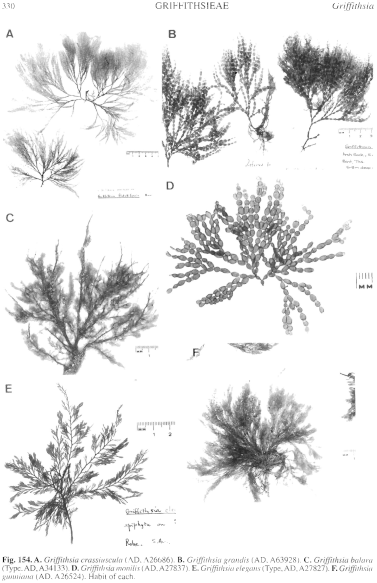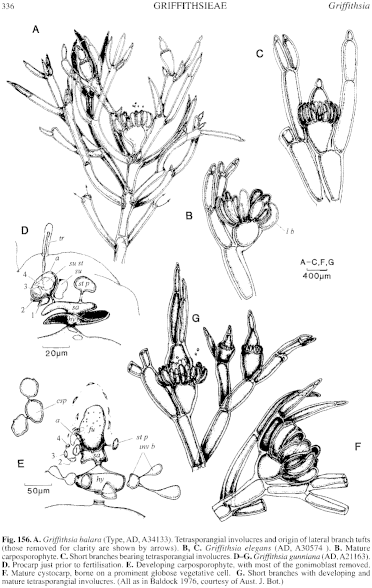|
|
|
|
|
|||||||||||
|
Electronic Flora of South Australia Species Fact Sheet
Phylum Rhodophyta – Order Ceramiales – Family Ceramiaceae – Tribe Griffithsieae
Thallus (Fig. 154E) light red, complanately branched, 4–11 cm high, with 1–6 main axes bearing from the upper shoulder of each cell regularly alternate, distichous, flabellate laterals 2–5 times subdichotomous. Attached by rhizoids; epiphytic or epilithic. Structure. Cells cylindrical, near the thallus apex 200–490 µm in diameter and L/D 3.5–6, in mid thallus 400–900 µm in diameter and L/D 2.5–3.5, basally 750–1010 µm in diameter and L/D 2.0–2.5, with 1–3 decurrent branched rhizoids, without haptera, produced from the lower part of each axial cell, entwining with axes to form a rope like mass 2–3 mm in diameter in the lower thallus.
Reproduction: Gametophytes dioecious. Hair-like synchronic laterals associated with reproductive structures present but inconspicuous. Female axes 3-celled, subapical but displaced laterally by the continued growth of the vegetative axis; procarp systems subapical, each with a sterile lateral cell and a supporting cell with a terminal sterile cell and recurved 4-celled carpogonial branch laterally; hypogenous cell producing abaxially 9–12, 2-celled synchronic involucral branches of which the larger incurved apical cells are 99–270 µm in diameter and L/D 3–4 and similar in size to vegetative lateral branch cells; post-fertilisation fusion cell columnar, bearing 1–3 gonimolobes terminally, most cells of which become angular-ovoid to clavate carposporangia, 35–40 µm in diameter; subhypogenous cell becoming ovoid, 420–610 µm in diameter and L/D 1–1.5, growth of vegetative lateral branches often inhibited by carposporophyte development (Fig. 156B). Spermatangia on whorls of minute polychotomous fascicles, from the upper shoulders of pyriform subapical cells 660–800 hm in diameter and L/D 1–1.3, which produce separately 12–18 single-celled synchronic involucral branches of elongate incurved cells, 130–150 in diameter and L/D 3–3.5, that enclose the spermatangial masses in a palisade-like structure; vegetative apical cells above the masses swollen, ovoid with short proximal necks, 500–600 µm in diameter and L/D 1.3–1.6, sometimes producing single, small conical cells apically, often shed so that a cupulate structure remains.
Tetrasporangia globose, 45–75 µm in diameter, produced successively in groups of 3–8 on masses of terete pedicels arising from the upper shoulders of swollen subapical vegetative cells in a similar position to the spermatangial fascicles, with similar swollen vegetative apical cells above, and palisade-like involucres developed separately from the vegetative cells bearing the fascicles (Fig 156C), although involucral cells are more elongate (L/D 4.4–4.8) and a small filament of 2–3 cells may be produced temporarily by the apical cell before both are shed.
Type from Robe, S. Aust. (Baldock, 19.v.1964); holotype in AD, A27827.
Selected specimens: Elliston Bay, S. Aust., 20 m deep (Shepherd, 14.v.1971; AD, A38706). West I., S. Aust., on hydroids, 16–19 m deep (Shepherd, 2.i.1967; AD, A31623) and 13m deep (Shepherd, June 1986; AD, A30574). Robe, S. Aust., on Sonderella linearis (Womersley, 9.ix.1968; AD A32682). Lawrence Rock, Portland Vic., on bryozoa, 30m deep (Owen, 2.ix.1971; AD A39676). The Rip, Port Phillip Heads, Vic., 16–20 m deep (Strachan, 5.iv.1995; AD, A67856, MELU, K10618). Gabo I., Vic., on Phyllospora comosa, 6 m deep (Shepherd, 15.ii.1973; AD, A43364). Adventure Bay, Bruny I. Tas., under Macrocystis, 10m deep (Shepherd, 16.ii.1972; AD, A41566).
Distribution: Elliston, S. Aust., to Portland, Vic. and SE Tasmania.
Taxonomic notes: G. elegans is often found in deep water, on larger algae. It belongs reproductively to the G. antarctica group, and smaller slender specimens may be confused with G. gunniana; however, the light red colour, and the complanate, regular and distichous branching are distinctive in G. elegans.
References:
BALDOCK, R.N. (1976). The Griffithsieae group of the Ceramiaceae (Rhodophyta) and its southern Australian representatives. Aust. J. Bot. 24, 509–593.
The Marine Benthic Flora of Southern Australia Part IIIC complete list of references.
Publication:
Womersley, H.B.S. (24 December, 1998)
The Marine Benthic Flora of Southern Australia
Rhodophyta. Part IIIC. Ceramiales – Ceramiaceae, Dasyaceae
©State Herbarium of South Australia, Government of South Australia
Illustrations in Womersley Part IIIA, 1998: FIGS 154E, 156 B–C.

Figure 154 enlarge
Fig. 154. A. Griffithsia crassiuscula (AD, A26686). B. Griffithsia grandis (AD, A63928). C. Griffithsia balara (Type, AD, A34133). D. Griffithsia monilis (AD, A27837). E. Griffithsia elegans (Type, AD, A27827). F. Griffithsia gunniana (AD, A26524). Habit of each.

Figure 156 enlarge
Fig. 156. A. Griffithsia balara (Type, AD, A34133). Tetrasporangial involucres and origin of lateral branch tufts (those removed for clarity are shown by arrows). B, C. Griffithsia elegans (AD, A30574 ). B. Mature carposporophyte. C. Short branches bearing tetrasporangial involucres. D–G. Griffithsia gunniana (AD, A21163). D. Procarp just prior to fertilisation. E. Developing carposporophyte, with most of the gonimoblast removed. F. Mature cystocarp, borne on a prominent globose vegetative cell. G. Short branches with developing and mature tetrasporangial involucres. (All as in Baldock 1976, courtesy of Aust. J. Bot.)

|
Email Contact: State Herbarium of South Australia |

|